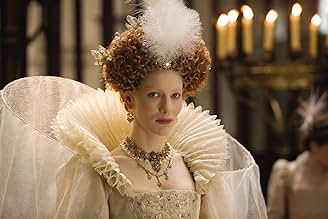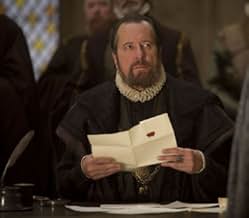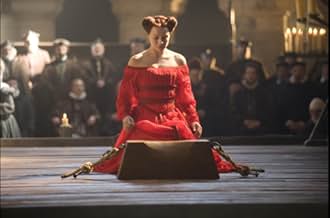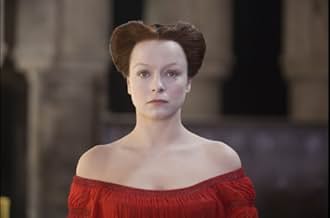Une reine Elizabeth mûre fait face à plusieurs situations de crise à la fin de son règne, dont des intrigues de la cour, un complot d'assassinat, la menace de l'Armada espagnole et des décep... Tout lireUne reine Elizabeth mûre fait face à plusieurs situations de crise à la fin de son règne, dont des intrigues de la cour, un complot d'assassinat, la menace de l'Armada espagnole et des déceptions amoureuses.Une reine Elizabeth mûre fait face à plusieurs situations de crise à la fin de son règne, dont des intrigues de la cour, un complot d'assassinat, la menace de l'Armada espagnole et des déceptions amoureuses.
- Réalisation
- Scénario
- Casting principal
- Récompensé par 1 Oscar
- 8 victoires et 33 nominations au total
- King Philip ll of Spain
- (as Jordi Molla)
Avis à la une
The set-up is rich with possibilities only partially realized on screen. Protestant England is on its knees, as Roman Catholic Spain has become Europe's most powerful country. Now in her early fifties, Elizabeth is vulnerable since Phillip II of Spain is intent on conquering England and especially because she has not married and produced an heir. Next in line is her cousin, Mary, Queen of Scots, a devout Roman Catholic imprisoned in a castle in Northamptonshire. Elizabeth has proved to be a tolerant ruler as she allows her country's Roman Catholics to maintain their religious beliefs, even though they see Mary as the only rightful Queen. In the meantime, Sir Walter Raleigh has just returned from the New World and stimulated Elizabeth's passion for adventure and her long-dormant desire for romance. Complicating matters is Elizabeth's devoted lady-in-waiting, Bess, a comely beauty who attracts Raleigh's attention. Just as this standard triangle is established, there is a threat on Elizabeth's life known historically as the Babington Plot. Mary is beheaded for her connection to the plot, which gives Philip free rein to gain the Pope's approval to attack England. Elizabeth inspires her troops to face off with the much larger Spanish Armada, and the rest, as they say, is history.
It's no surprise that Cate Blanchett commands the screen in the title role and does her best to fill in the blanks left by the routine script. She manages to imbue the Queen with a hidden vulnerability at which comparatively imperious predecessors like Bette Davis and Glenda Jackson merely hint. The one drawback is that she is too young for the role, a point emphasized by the periodic and somewhat conceited use of flashbacks from the previous film in which her appearance has not changed significantly despite the make-up. Geoffrey Rush returns from the first film as Elizabeth's adviser, Sir Francis Walsingham, but he has less to do this time. As Raleigh, Clive Owen has no problem playing a dashing figure, but he seems more like a romantic's fabrication of what a bodice-ripping swashbuckler should be. Speaking with a strange burr, Samantha Morton has precious few scenes as the fanatical but forgiving Mary, and her pouty face and petulant manner seem at odds with previous characterizations. As Philip, Jordi Mollà is forced to play the king as a religious zealot, while Abbie Cornish's Bess strikes me as far too contemporary in manner to be credible as a lady-in-waiting, especially with the ongoing hints of lesbianism and a soft porn-like lovemaking scene with Raleigh.
Guy Dyas' production design, Alexandra Byrne's costumes and Remi Adefarasin's cinematography are all impressive in their splendor and meticulous detail, though I found the music by Craig Armstrong and A.R. Rahman far too intrusive. There are several extras with the 2008 DVD release starting with Kapur's commentary track, often insightful but excessively verbose. An eleven-minute making-of featurette is included, of course, but it is pretty standard with plenty of now-and-then comparisons with the 1998 film. Three other shorts are included one on Dyas' intensive work on the production design, one on the recreation of the climactic battle with a mix of ship replicas and CGI, and one on the actual locations used for the filming. There are nine minutes of deleted and extended scenes including one that too-realistically shows Mary's decapitated head. None of these extras helps make the experience of watching this film any more involving.
The picture talks about Mary Queen of Scots (Samantha Morton) , she and Elizabeth were rivals for power in Tudor England . The heathen Protestant Elizabeth dreads the prospect of the Catholic Mary about her ascending the English throne, leading to intrigue and divisiveness within the court. Then Mary was imprisoned by Elizabeth , who rightly feared Catholic plots to place Mary on the throne. Mary was guilty of plots complicity and was condemned death warrant . The film especially describes relations between Spain ruled by Philip II (Jordi Molla) and England at the breaking point . Spectacular battle scenes between the British Navy commanded by Duke of Effiham and Raleigh and the Spanish commanded by Duke of Medina Sidonia , it lasted ten days , during July 1588 . At the climax William Raleigh leads the attack on the Armada ships massed off the British coast .
Blanchett, of course, is terrific, and doesn't seem to mind that the screenwriters have turned her signature character into a woman with split personalities: a raving love-scorned woman in private who constantly crumbles under pressure, and a powerful monarch who commands the wind and becomes a divinity to her people in public. Elizabeth has no character arc here like she did in the original film that saw her mature from frightened princess to calculating queen. The sequel suffers from this lack of development for its titular historical icon, but Blanchett rules the madhouse with an iron fist, chewing the scenery when necessary for dramatic effect and maximum entertainment value.
The sequel also suffers from too much focus on a silly love triangle involving Elizabeth, Sir Walter Raleigh (an uninspired Clive Owen), and one of her ladies in waiting (a ravishingly gorgeous but ultimately lifeless Abbie Cornish). The rest of the film covers events that were already treated in a more respectful and quietly powerful manner in HBO's miniseries starring Helen Mirren. These include Elizabeth's divisive relationship with Mary Stuart (a blistering Samantha Morton doing an entertaining bit of over-acting), and the defeat of the Spanish Armada, whose sinking is done up in a rock opera style that serves as a guilty pleasure to watch.
Meanwhile, director Kapur, who never saw an overhead shot, candlelit scene, or 360 degree crane movement he didn't love, uses his bigger budget to ridiculously grand effect creating immaculate set designs populated with over the top costuming and epic pageantry. "Elizabeth: The Golden Age" is completely unnecessary, but despite some of its stunning ineptitude, it turns out not to be a colossal waste of time and will entertain those who will allow it to bludgeon them. Where the first film was a smart period piece inspired by "The Godfather", the silly sequel is a dumb art-house film inspired by obnoxious action flicks. Blanchett, who hopefully will become more selective in her roles as she ages, oddly seems at home in both. I'm not sure if that's the mark of a great actress or a desperate movie star.
In addition to Blanchett, the supporting cast all turn in superior work. The sets, costuming, and period speech are all mastered well, creating a true feel for the era being depicted. Although many of the people and events are real, a few liberties have been taken apparently to spice up the drama. Such fictionalizing probably wasn't necessary; enough happened during this queen's rule to make the story interesting without it. One example: the flashy Sir Walter Raleigh was indeed a favorite of the queen, but this movie puts them in a romantic triangle that just gets in the way of other things going on. Also, Raleigh, better known as an explorer, was not the hero in the battle with the Spanish Armada.
Blanchett shines when she delivers the famous speech to the troops on the eve of the Spanish invasion. But even she is burdened by the director's preoccupation with Elizabeth as a suffering angst-filled woman facing middle-age with less bravery than facing the world's most powerful fleet at that time. We get endless views of her taking her wig off in secret, and staring at a mirror. The first time this device is used is fine to get the point across of her hopeless situation of never taking a husband (and the slow advance of time having its way), but we see her looking like a shriveled ghost in too many such scenes, and it's way overdone in this context. Her "real" hair sans the wig looks like an inebriated Edward Scissorhands was her hairdresser, and her pale complexion looks like somebody pasted white-out all over her face.
Those few mistakes notwithstanding, this is a fine biopic with superior acting by Blanchett, and is recommended.
They could have made this a spectacular movie, nice story, great costumes. But after the first 45 minutes it get boring and you ask yourself why. Then towards the end i hoped to see a great battle at sea, but it didn't happen.
The movie is watchable but don't expect too much.
It might be wiser to rent this one on DVD instead of going to the movies.
Le saviez-vous
- AnecdotesWhen Elizabeth arrives at St. Paul's Cathedral, construction is going on. In real life, St. Paul's actually needed repair work. Director Shekhar Kapur decided to improvise and gave the workers costumes and period tools to cut real stone that was being installed in the cathedral. The workers in the scene are real-life stonemasons and construction workers.
- GaffesThe real Babington Plot to assassinate Queen Elizabeth at the altar was thwarted in the planning stages.
- Citations
Queen Elizabeth I: Go back to your rathole! Tell Philip I fear neither him, nor his priests, nor his armies. Tell him if he wants to shake his little fist at us, we're ready to give him such a bite he'll wish he'd kept his hands in his pockets!
Don Guerau De Spes: You see a leaf fall, and you think you know which way the wind blows. Well, there is a wind coming, Madame, that will sweep away your pride.
[turns to leave with his ministers]
Queen Elizabeth I: I, too, can command the wind, sir! I have a hurricane in me that will strip Spain bare if you dare to try me!
- ConnexionsEdited from La Fille de Ryan (1970)
- Bandes originalesVolta a 4
Written by John Dowland
Performed by The Consort of Musicke
Conducted by Anthony Rooley
Courtesy of The Decca Record Company Ltd
Under licence from Universal Music Operations Ltd
Meilleurs choix
Détails
- Date de sortie
- Pays d’origine
- Langues
- Aussi connu sous le nom de
- Elizabeth: La edad de oro
- Lieux de tournage
- Sociétés de production
- Voir plus de crédits d'entreprise sur IMDbPro
Box-office
- Budget
- 55 000 000 $US (estimé)
- Montant brut aux États-Unis et au Canada
- 16 383 509 $US
- Week-end de sortie aux États-Unis et au Canada
- 6 153 075 $US
- 14 oct. 2007
- Montant brut mondial
- 75 782 758 $US
- Durée1 heure 54 minutes
- Couleur
- Mixage
- Rapport de forme
- 1.85 : 1
Contribuer à cette page










































